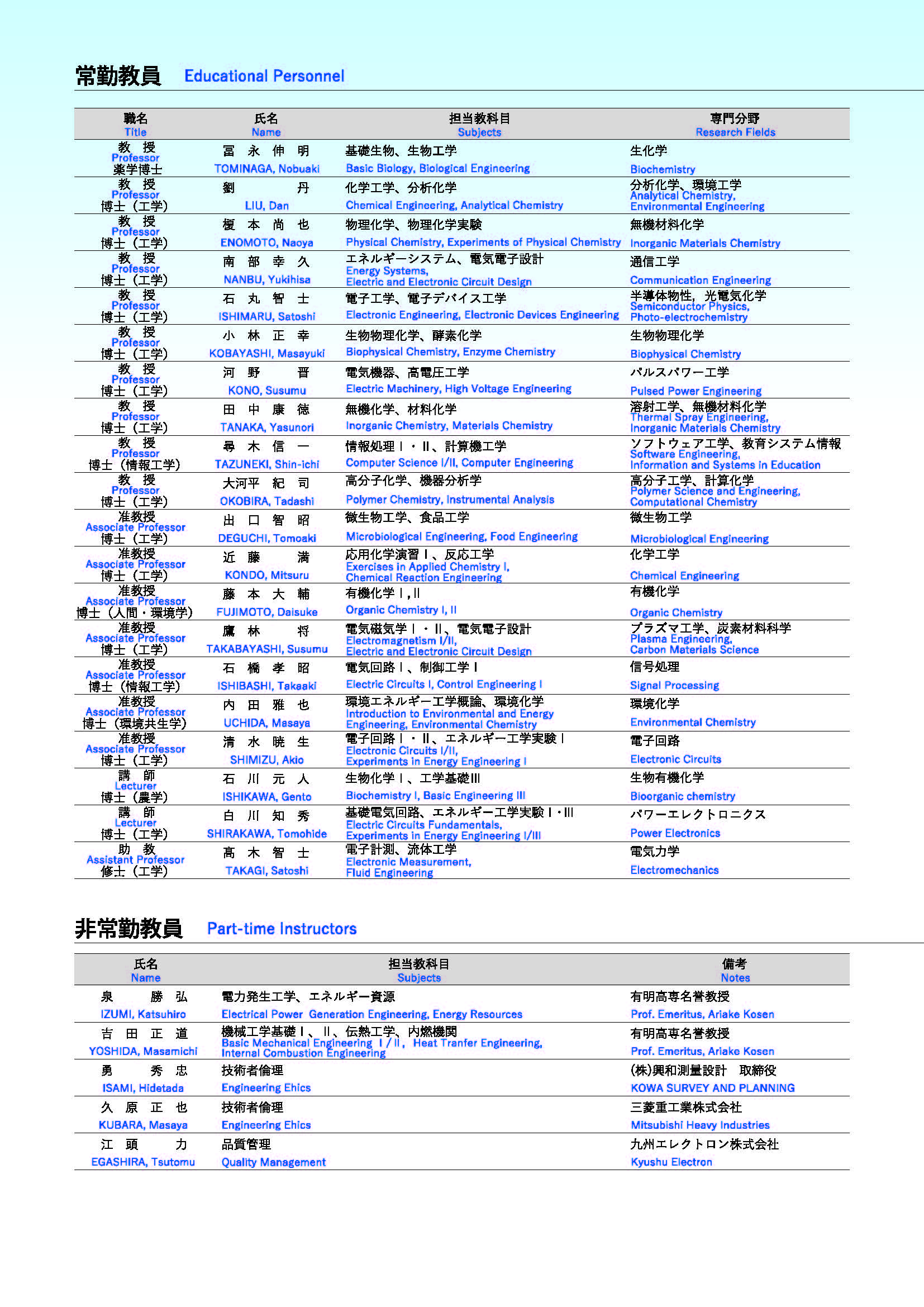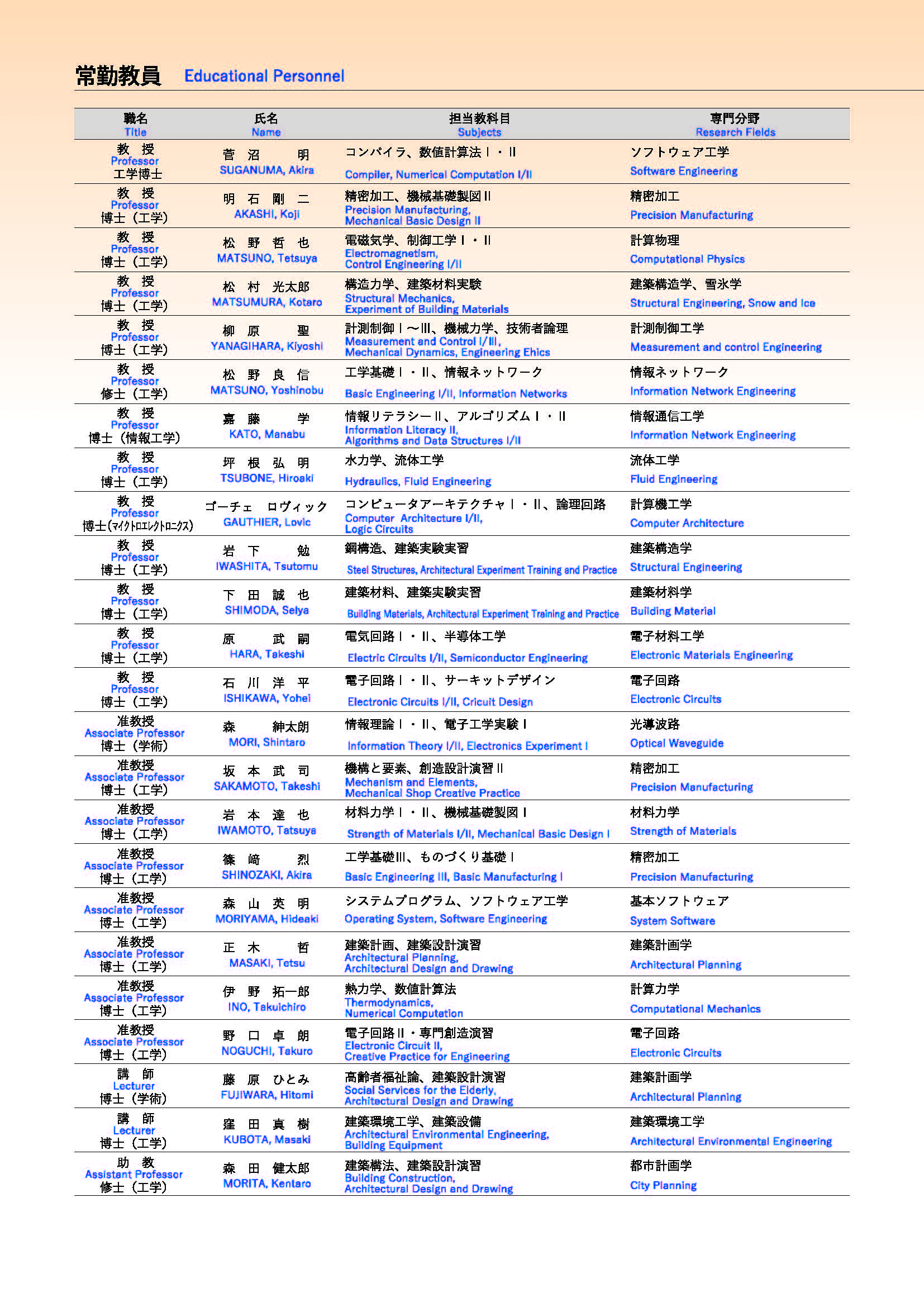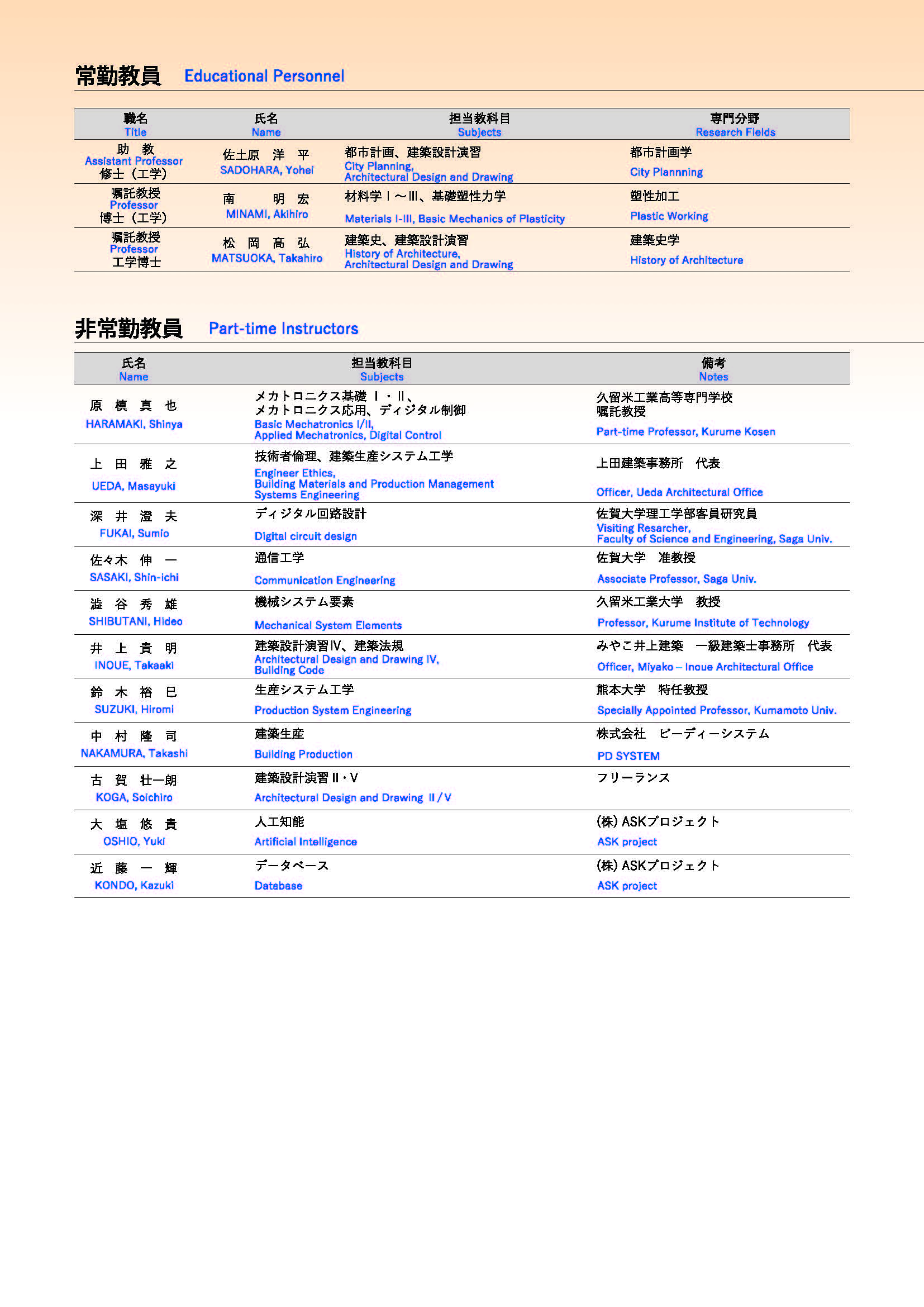Department of Creative Engineering
Modern technology and engineering has become increasingly complex, multifaceted, and globalized. Engineers can no longer be hyperspecialized in only one field but must rather be broadminded and capable of working cooperatively across specializations, cultures, and languages. The Department of Creative Engineering attempts to produce such engineers through its two different divisions and six courses.
The first one and a half years are spent in widely ranging basic studies that cover many different fields of specialization, after which, students may select their major course of study. This will insure that students have been exposed to both the basic aspects of science and technology but also develop the in-depth skills they are likely to need in the future.
Each course is designed to motivate students to conduct research appropriate to their developmental stage. The aim of which is to trains students to be both creative and practical.
To complement their specialized and technical knowledge, students are also encouraged to develop a deep world historical view, philosophical thinking, knowledge of politics, economics, and language. Graduates are expected to be globally minded engineers with the ability to work actively worldwide.
Diploma Policy : Policy on certifying graduation
We certify the graduation of those who have achieved all of the learning and education goals of the Creative Engineering Department, which aims to train the following types of engineers who can flexibly respond to medern challenges such as natural disasters and the aging society, by completing its entire course, and grant them diplomas.
1) Engineers with broad, fundamental engineering knowledge and independence.
2) Engineers who have advanced knowledge and creativity in specialized engineering and who have acquired practical skills.
3) Engineers who are capable of self-development and improvement, and who can contribute to the development of society through “Monozukuri (manufacturing)”.
4) Engineers who understand diverse values and can play an active role in interdisciplinary technial fields.
5) Engineers with broad vision and education who can play an active role in the international community.
Curriculum Policy
At Ariake Institute of Technology, in order to train the human resources indicated in the DP, the curriculum of the Creative Engineering Department will be organized and implemented according to the following unique policies. The credits for the following subjects will be recognized based on the results of regular examinations and reports.
1) The first and second year courses consist of five classes in one course of study of the department of Creative Engineering, and the curriculum is made up of general education subjects and basic engineering subjects.
2) Beginning in the second semester of the second year, the course will be divided into two groups and six courses, and the specialized education subjects of each course will be provided. The higher the grade, the higher the ratio of specialized education subjects.
3) Specialized education subjects include subjects common to both divisions, which are the basis of each division, and major course subjects in which students can learn everything from the basics of each specialty yo applications. For major course subjects in which students actively collaborate with others to solve problems.
4) For general education subjects, we have set up subjects to respond to globalization, including social studies, Japanese and foreign languages, as well as refinement courses in natural sciences, including mathematics, physics and chemistry.
5) In the second semester of the fourth year and in the fifth year, in addition to the major course subjects, graduation research for the writing of graduation theseswill be conducted.
Admission Policy
Ariake Institute of Technology, so that our students can study our curriculum based on the CP with hopes and dreams in line with DP, seeks the following kind of junior high school graduates with basic academic skills.
1) People interested in “Monozukuri (manufacturing)”
2) People with a spirit of taking on challenges
3) People who can work with others
4) People who can continue something tenaciously
5) People who want to contribute to society
Division
Division of Environmental and Energy Engineering
The object of the Division of Environmental and Energy Engineering is preserving “nature”. The goal of this division is to train students to be engineers who deal with various environmental issues such as energy and food production. These issues have to be addressed for building a sustainable society.
The Division of Environmental and Energy Engineering is composed of three courses: “Energy,” “Applied Chemistry,” and “Life and Environmental Science”. These three technological fields are necessary for addressing the issues mentioned above.
The development of new industries in environmental and energy focuses on the “Ariake area,” where our college is located. This educational program aims at solving local issues through collaboration with local government and companies.
This division offers some subjects in common among the three courses, which contain lectures and exercises on environmental and energy engineering as fundamental subjects. Studying these subjects will lead students to be successful engineers in these fields. These courses give students both basic and advanced level of environmental and energy technologies and related fields.
<Education Purposes>
The goal of this division is to train our students to be engineers who can meet environmental challenges, and deal with various problems of the environment, energy, and food. Therefore, this division welcomes students with the following qualities.
1) Students who have motivation to study mathematics and science, and are interested in conducting experiments.
2) Students who have a strong desire to acquire knowledge in specialized fields.
3) Students who take a scientific interest in a wide range of subjects.

Division of Human and Welfare Engineering
The goal of the Division of Human and Welfare Engineering is improving the quality of “people’s lives.” The division’s purpose is to train engineers who can solve problems related to people such as urban living and adapting to an aging society such that quality of life can be improved.
This division contains three courses: “Mechanical Engineering,” “Information System Engineering” and “Architecture.”
The “Ariake area” has been facing many problems caused by the closure of the Miike Coal Mine. The area also has to cope with population decline and an aging society. In this division, these issues are incorporated into educational programs.
In the fundamental education, some subjects common to the three courses are offered to the students. The subjects cover social life, social welfare, life support, vital functions, and human engineering. Through studying both in the classroom and in the field, the course produces engineers able to deal with these and related problems. In each course, both the fundamental subjects and applied subjects are offered to the students.
<Education Purposes>
The goal of this division is to develop engineers who can solve many problems, such as the urban problem and the aging society problem for the improvement of people’s quality of life. Therefore, this division welcomes students with the following qualities.
1) Students who are interested in mathematics, science, and other related subjects.
2) Students who are interested in mechanics and principles of things and have intentions to acquire technical knowledge.
3) Students who have intentions to enrich the lives of people through manufacturing.

